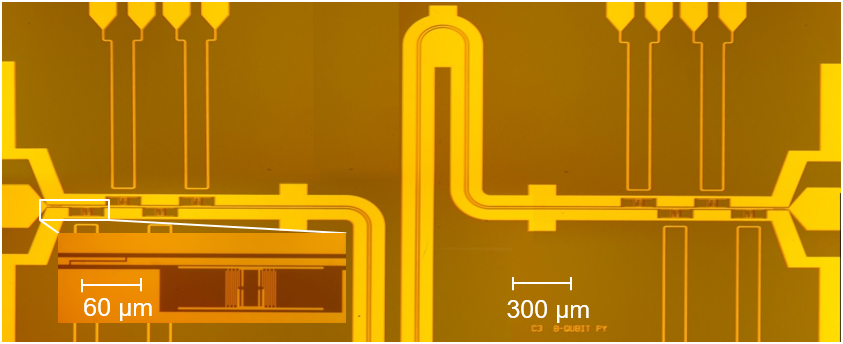
Our Research
Quantum Simulation and Computing
Analog quantum simulation of the Rabi model in the ultra-strong coupling regime
Jochen Braumüller, Michael Marthaler, Andre Schneider, Alexander Stehli, Hannes Rotzinger, Martin Weides & Alexey V. Ustinov
Nature Communications 8, 779 (2017)
Light-matter interaction described by Rabi model has dynamic states not exactly solvable: Analog quantum simulation scheme of Rabi-model by moving into the rotationg frame of applied microwave drives
- Effectively reduced transition frequencies of qubit (matter) and resonator (photon)
- Decay, idling and revival of qubit state observed
⇒Effective coupling g/ωeff~0.6 (ultra-strong coupling of light-matter) demonstrated
Outlook: how to probe the spin-boson system (theoretical work)?
⇒Quantum simulation of the spin-boson model in a microwave circuit
Juha Leppäkangas, Jochen Braumüller, Alexey V. Ustinov, Martin Weides, and Michael Marthaler
Physical Review A, 97(5), 052321.
Probing the Tavis-Cummings level splitting with intermediate-scale superconducting circuits
Ping Yang, Jan David Brehm, Juha Leppäkangas, Lingzhen Guo, Michael Marthaler, Isabella Boventer, Alexander Stehli, Tim Wolz, Alexey V. Ustinov, Martin Weides
Phys. Rev. Applied 14, 024025 (2020)
An array of eight superconducting qubits for quantum simulation of matter-light interaction is demonstrated. We show a qubit ensemble coupled to a microwave cavity and confirmation of its potential as analog quantum simulator for the Tavis-Cummings Hamiltonian. Our scheme
- harnesses the local control of each level transition
- shows a path to mitigate noise
- demonstrates control and readout of quantum coherent mesoscopic multi-qubit system of intermediate scale
Our findings bring insights into future circuit designs, and have implications for the field of near-term quantum simulation of ground states and dynamics in matter
Correlating decoherence in transmon qubits: Low frequency noise by single fluctuators
Steffen Schlör, Jürgen Lisenfeld, Clemens Müller, Andre Schneider, David P. Pappas, Alexey V. Ustinov, Martin Weides
Phys. Rev. Lett. 123, 190502 (2019)
Long-term measurements of a highly coherent, non-tunable transmon qubit reveal low-frequency burst noise in coherence times and transition frequency.
- simultaneous measurement of the qubits relaxation and dephasing rate as well as its resonance frequency
- analysis of their correlations and estimate spectral noise analysis
- indicates microscopic origin of the intrinsic decoherence mechanisms
⇒Small number of microscopic two-level systems located at the edges of the superconducting film
Concentric transmon qubit featuring fast tunability and an anisotropic magnetic dipole moment
Jochen Braumüller, Martin Sandberg, Michael R. Vissers, Andre Schneider, Steffen Schlör, Lukas Grünhaupt, Hannes Rotzinger, Michael Marthaler, Alexander Lukashenko, Amadeus Dieter, Alexey V. Ustinov, Martin Weides, David P. Pappas
Appl. Phys. Lett. 108, 032601 (2016)
- Improved coherence
- Level tuning within nanoseconds
- Gate benchmarking (99.54%)
- Allows for non-stoquasticcoupling
- 1d Fermi-Hubbard maps to bilinear chain with XX+ZZ coupling
Multi-photon dressing of an anharmonic superconducting many-level quantum circuit
Jochen Braumüller, Joel Cramer, Steffen Schlör, Hannes Rotzinger, Lucas Radtke, Alexander Lukashenko, Ping Yang, Sebastian T. Skacel, Sebastian Probst, Michael Marthaler, Lingzhen Guo, Alexey V. Ustinov, and Martin Weides
Phys. Rev. B 91, 054523 (2015)
We observe multiphoton transitions via virtual energy levels of our system up to the fifth excited state.
- multiphoton dressing within the anharmonic circuit
- higher-order Rabi sidebands and associated Autler-Townes splittings involving up to five levels of the investigated anharmonic circuit
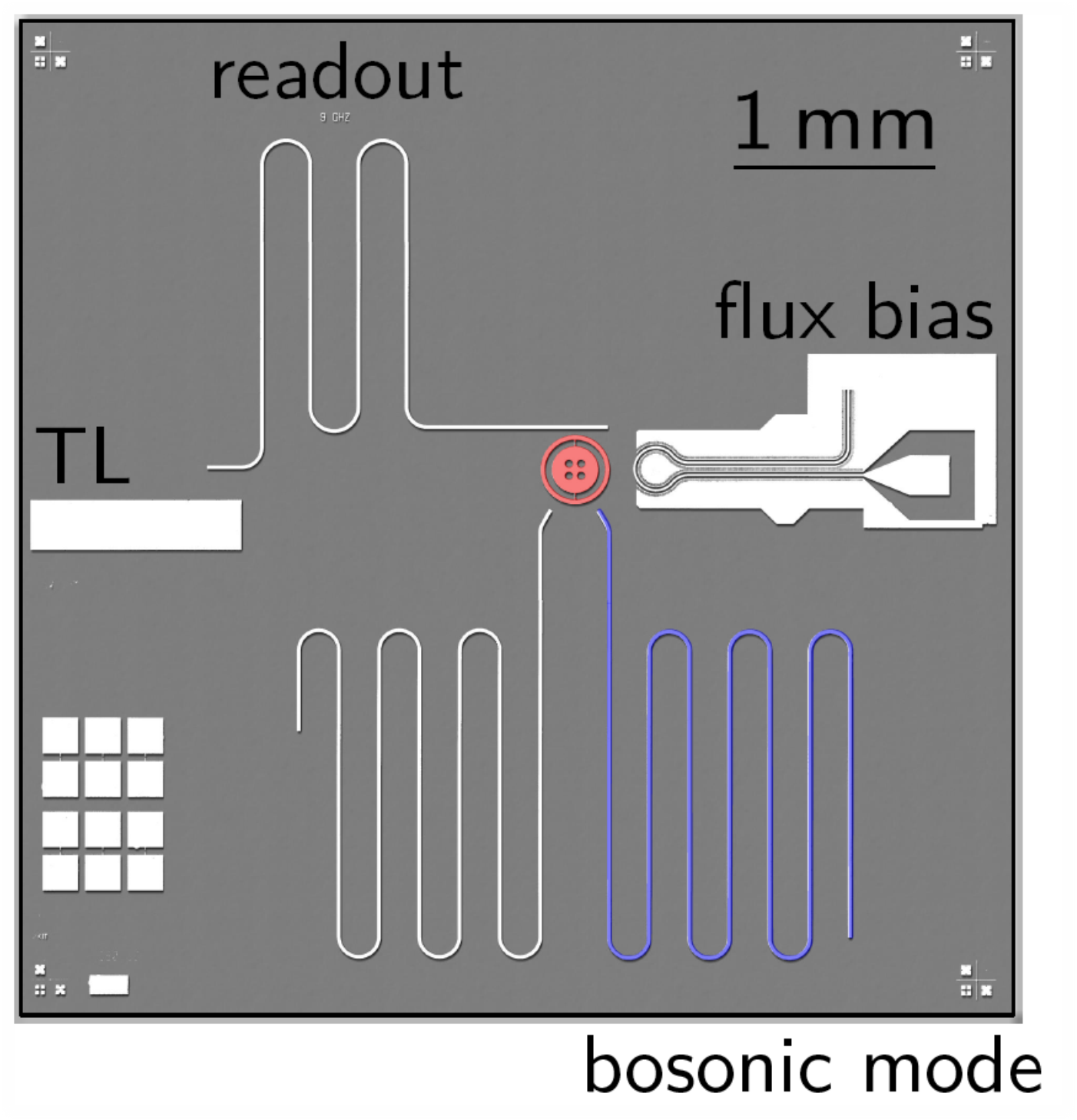
Frequency-tunable concentric transmon qubit (red) ultra-strong coupled to the harmonic resonator (blue) in the rotating frame.
Quantum Sensing
Local sensing with the multilevel ac Stark effect
Schneider, A., Braumueller, J., Guo, L., Stehle, P., Rotzinger, H., Marthaler, M., Ustinov, A. V. and Weides, M.
Physical Review A, 97, 062334 (2018)
Goal:determine microwave tone (frequency and amplitude)
- Analytic model of the higher level AC Stark shifts
- Good agreement btw. measured & simulated & analytics
⇒Fast alternative to Rabi oscillations (requiring tunable qubit)
Amplitude and frequency sensing of microwave fields with a superconducting transmon qudit
M. Kristen, A. Schneider, A. Stehli, T. Wolz, S. Danilin, H. S. Ku, J.Long, X. Wu, R. Lake, D. P. Pappas, A. V. Ustinov, and M. Weides
https://arxiv.org/pdf/1908.09556.pdf
Time-resolved measurements to detect
- on-chip amplitude and frequency of a microwave signal
- over a range of several hundreds of MHz with an energy sensitivity on the order of 1E-4.
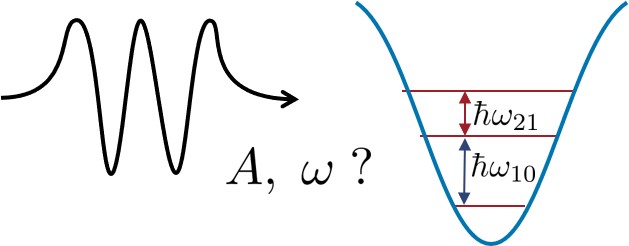
AC Stark shift of three-level quantum circuits reveals amplitude and frequency of microwave signal
Magnonics
Complex temperature dependence of coupling and dissipation of cavity magnon polaritons from millikelvin to room temperature
Boventer, I., Pfirrmann, M., Krause, J., Schön, Y., Kläui, M. and Weides, M.
Physical Review B, 97(18), 184420 (2018)
Hybridized magnonic-photonic systems are key components for future information processing technologies such as storage, manipulation, or conversion of data both in the classical (mostly at room temperature) and quantum (cryogenic) regime. We investigate a yttrium-iron-garnet sphere coupled strongly to a microwave cavity over the full temperature range from 290 K to 30 mK.
- electromagnonic cooperativity in excess of 20 over the entire temperature range, with values beyond 100 in the millikelvin regime as well as at room temperature.
- Spectroscopy on strongly coupled magnon-photon systems is demonstrated as a versatile tool for spin material studies over large temperature ranges.
- Key parameters are provided in a single measurement, thus simplifying investigations significantly.
Interplay of magnetization dynamics with microwave waveguide at cryogenic temperatures
I. A. Golovchanskiy, N. N. Abramov, M. Pfirrmann, T. Piskor, J. N. Voss, D. S. Baranov, R. A. Hovhannisyan, V. S. Stolyarov, C. Dubs, A. A. Golubov, V. V. Ryazanov, A. V. Ustinov, and Weides, M.
Phys. Rev. Applied 11, 044076 (2019)
Magnetization dynamics is studied at low temperatures in a hybrid system that consists of the thin epitaxial magnetic film coupled with superconducting planar microwave waveguide. The substantial influence of the superconducting critical state on the resonance spectrum is observed and discussed. 'Cryogenic magnonics' opens avenues to
- substantially different FMR properties
- no thermal degradation
- engineered additional anisotropies
- and hybridization of magnonic media with superconductors
Magnons at low excitations: Observation of incoherent coupling to a bath of two-level-systems
Marco Pfirrmann, Isabella Boventer, Andre Schneider, Tim Wolz, Mathias Kläui, Alexey V. Ustinov, Martin Weides
Phys. Rev. Research 1, 032023(R) (2019)
At typical experimental conditions for quantum hybrids, we observe excess magnetic excitation losses due to incoherent coupling to a bath of two-level-systems. Our results add
- to the understanding of fundamental limits of magnetic excitations
- show the current limitations of excitation lifetimes due to intrinsic losses in state-of-the-art samples
⇒inspire future improvements of magnetic hybrid quantum systems and nanofabrication
Introducing coherent time control to cavity magnon-polariton modes
Tim Wolz, Alexander Stehli, Andre Schneider, Isabella Boventer, Rair Macêdo, Alexey V. Ustinov, Mathias Kläui & Martin Weides
Commun Phys 3, 3 (2020)
Fast manipulations of the different cavity magnon-polaritons modes with independent but coherent pulses to the cavity and magnon system
- to establish dynamic and on-demand control of the CMP within nanoseconds
- to control building blocks valuable for a quantum internet
- to pave the way for future magnon-based quantum computing research
⇒flexible platform that intrigues fundamental coherent control of the strong light-matter interaction dynamics.
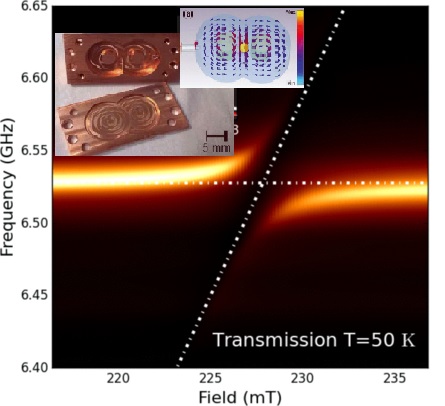
Magnon mode strongly coupled to a microwave cavity
Quantum Technology
Efficient and robust analysis of complex scattering data under noise in microwave resonators
S. Probst, F. B. Song, P. A. Bushev, A. V. Ustinov, and Martin Weides
Rev. Sci. Instrum. 86, 024706 (2015)
Reliable determination of external and internal quality factors using
- the circle fit technique including diameter correction
- step by step guide for implementing an algorithm for robust fitting and calibration of complex resonator scattering data in the presence of noise.
The speedup and robustness of the analysis are achieved by employing an algebraic rather than an iterative fit technique for the resonance circle.
The fitting routine is part of the open-source software QKIT, https://github.com/qkitgroup/qkit, providing
- Python notebooks
- hdf5 data storage
- Flexible data viewer
- Instrument drivers, fitting classes
Resonance inversion in a superconducting cavity coupled to artificial atoms and a microwave background
Juha Leppäkangas, Jan David Brehm, Ping Yang, Lingzhen Guo, Michael Marthaler, Alexey V. Ustinov, Martin Weides
Phys. Rev. A 99, 063804 (2019)
Transmission through superconducting cavity coupled to eight artificial atoms is analyzed. We demonstrate how the heating of an environment can invert the line shape of a driven cavity.
- Measured cavity transmission is characterized by Fano-type resonances with a shape that is continuously tunable by bias current through nearby (magnetic flux) control lines.
- We find generally that resonance positions determine system energy levels, whereas resonance shapes give information on system fluctuations and dissipation
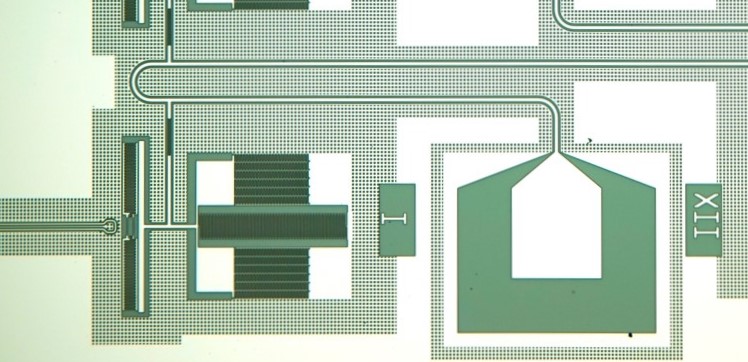
A selection of quantum circuit elements in our lab: qubit, resonator and microwave launcher (left to right)

